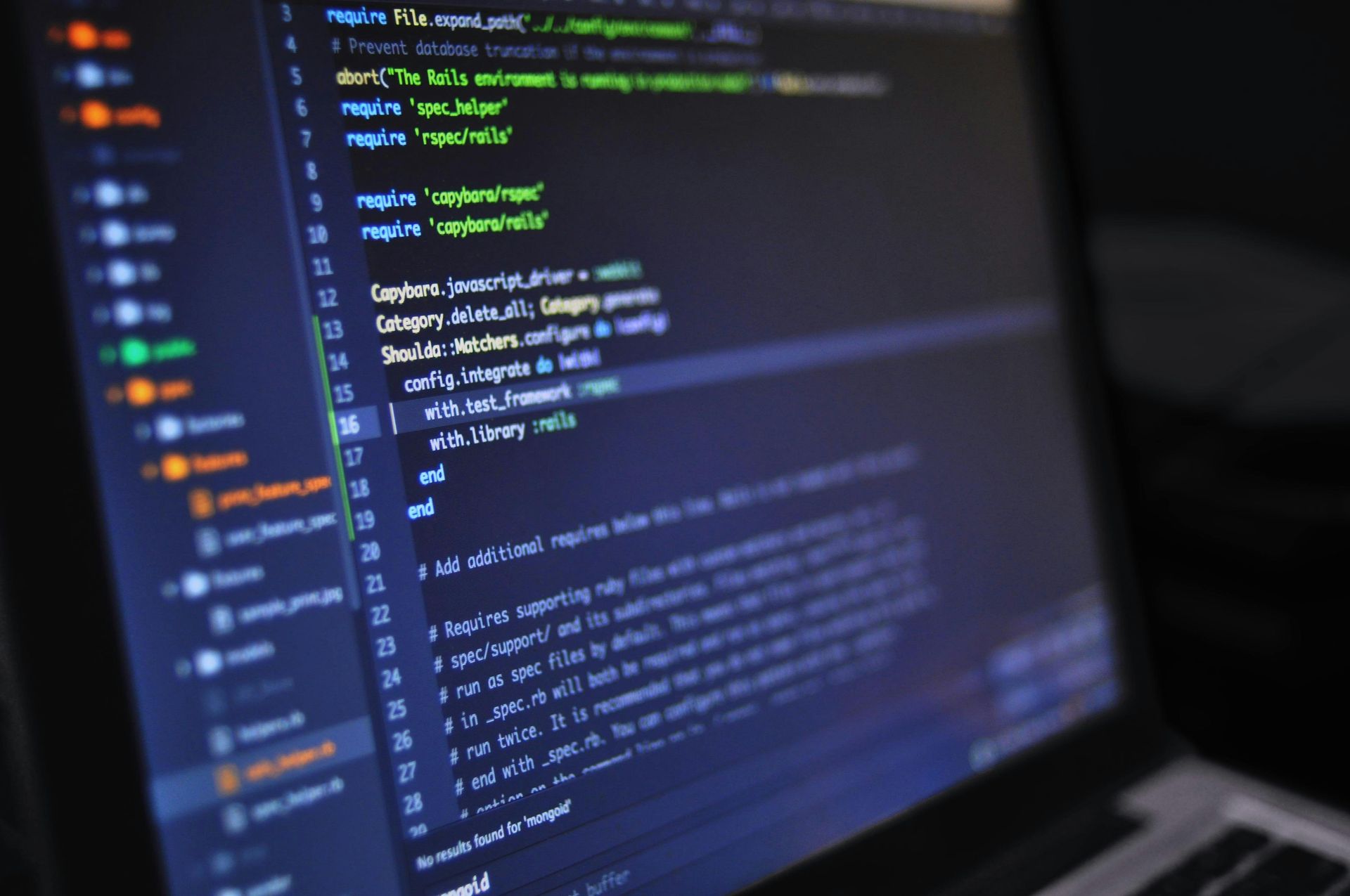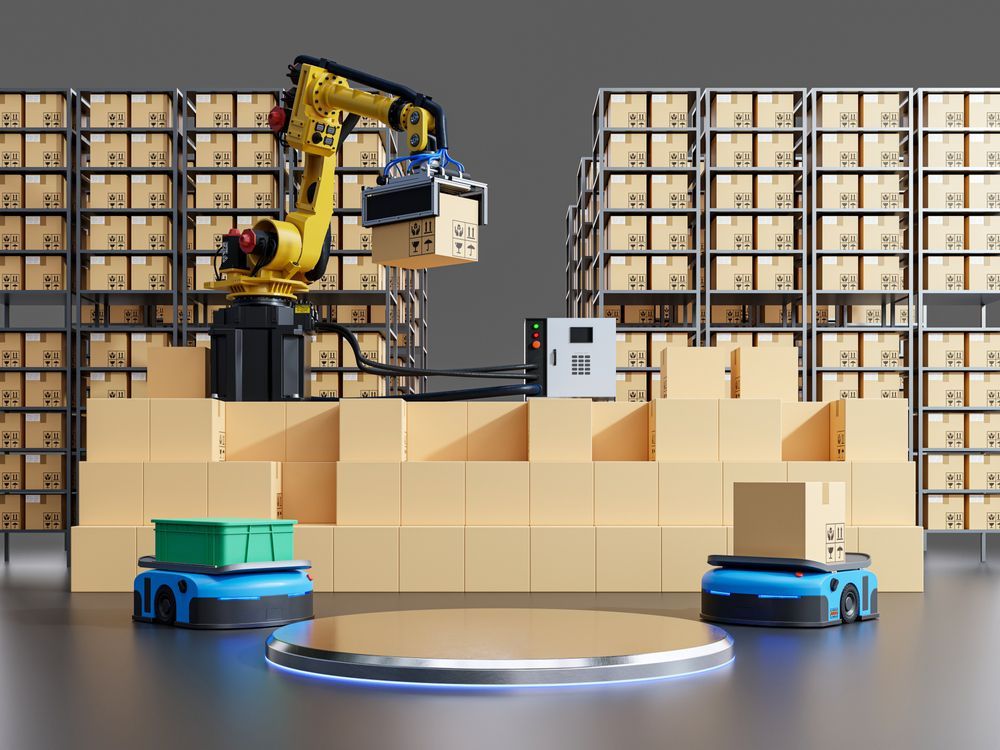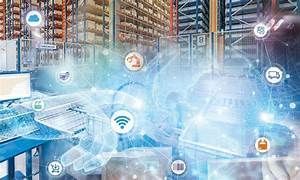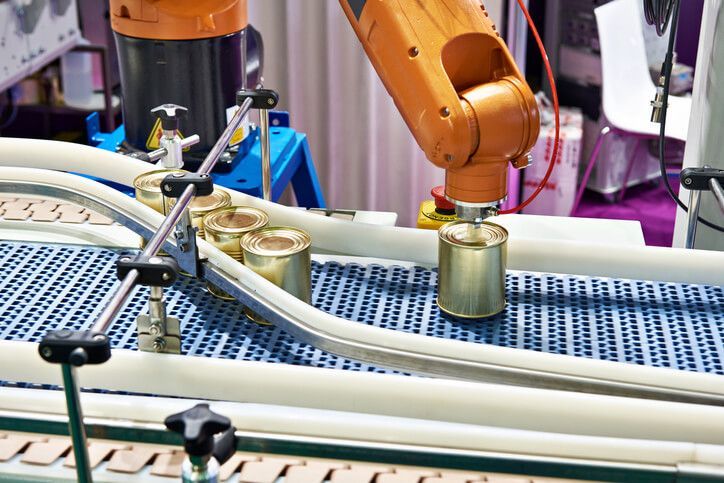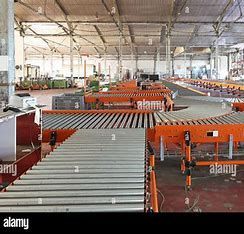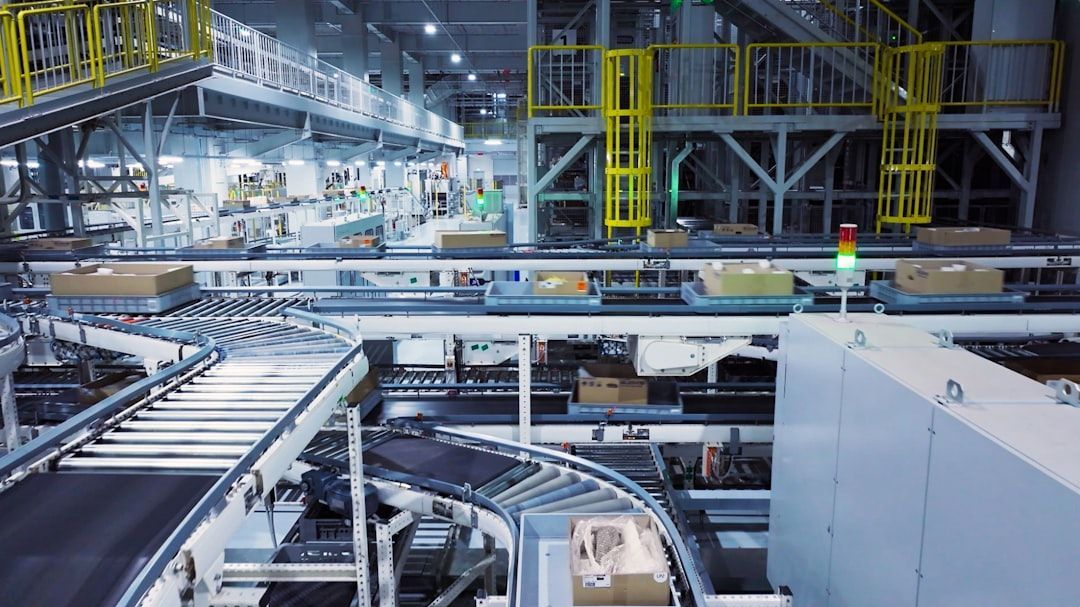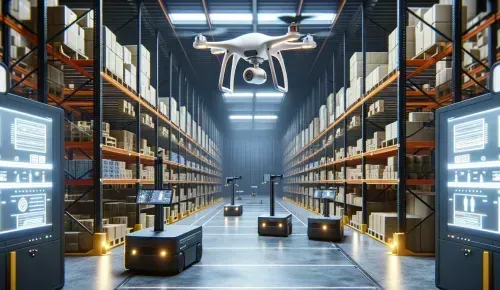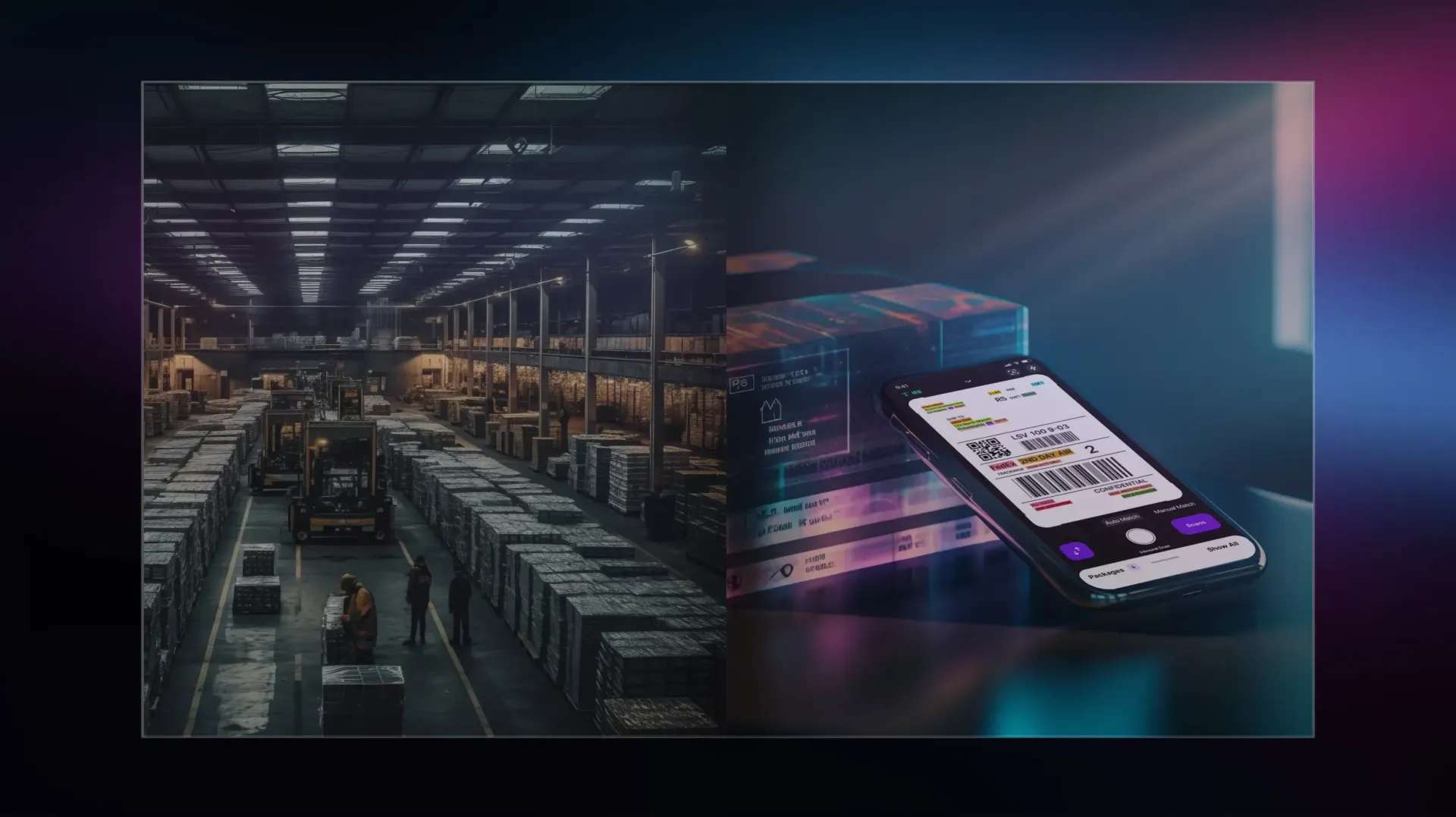Vorstellen,
eine Welt, in der Ihr Paket blitzschnell und präzise ausgewählt, verpackt und ausgeliefert wird – und das alles ohne menschliches Eingreifen.
Entdecken,
wie Ihnen modernste Technologien dabei helfen können, Logistikprozesse zu automatisieren.
Erweitern,
die Effektivität Ihrer Logistikabläufe mit speziellen Lösungen von 3S.
Schöpfen Sie das Potenzial der Logistikautomatisierung: Überdenken Sie die Lieferkette
In der heutigen schnelllebigen digitalen Landschaft sind effiziente und optimierte Logistikabläufe entscheidend für den Erfolg. Durch die Automatisierung verschiedener Aspekte Ihrer Logistikprozesse können Sie Zeit sparen, Kosten senken und die Kundenzufriedenheit steigern. Die Automatisierung in der Logistik verbessert die Logistikabläufe mithilfe von Software, die einen Teil der von Menschen verwalteten Prozesse übernimmt, oder mithilfe von Maschinen, die einen Teil der manuellen Aufgaben übernehmen.
Erfahren Sie, wie 3S Ihr Unternehmen mit speziellen Lösungen zur Logistikautomatisierung unterstützen kann.
Informieren Sie sich, wie wir Sie dabei unterstützen können, die wichtigsten Ziele zu ermitteln, die Ihr Unternehmen mithilfe der Logistikautomatisierung erreichen kann, die auftretenden Herausforderungen zu bewältigen, ein Logistikautomatisierungssystem auszuwählen, bewährte Methoden zur Implementierung bereitzustellen und umsetzbare Erkenntnisse zur Optimierung Ihrer Betriebsabläufe zu bieten.
Automatisierung im Wareneingang
Wenn eingehende Waren mit Barcodes gekennzeichnet sind, wird das Automatisierungssystem automatisch über deren Ankunft informiert. Dies erleichtert das Scannen und die ordnungsgemäße Identifizierung der Waren, was wiederum eine korrekte Qualitätsbewertung und Übergabe an die fest installierten Maschinen im Lager oder in der Vertriebseinheit gewährleistet. Es hilft Ihrem System dabei, die Waren den entsprechenden Förderbändern, Kränen, Sortiersystemen oder Lagerregalen zuzuordnen.
Automatisierung in der Disposition
Wenn die Logistikfunktionen durchgängig automatisiert sind, kann Ihr Automatisierungssystem ausgehende Waren effizient den entsprechenden Versandeinheiten und Ausgangsbeständen zuordnen. Dadurch werden nicht nur die von Maschinen ausgeführten Aufgaben optimiert, sondern auch der menschliche Aufwand und die Kosten können reduziert werden.
Automatisierung in der (Um-)Verpackung
Durch Automatisierung der Prozesslogistik können Verpackungs- und Umverpackungsprozesse beschleunigt werden, wodurch Ihr Unternehmen viel Geld bei den Personalkosten einspart.
Automatisierung der Warenabholung
Ihr Automatisierungssystem kann bei Eingang einer Bestellung automatisch bestimmte Waren aus Ihrem Lagerbestand lokalisieren und abrufen. Anschließend kann es das Produkt für den Versand und die Lieferung vorbereiten.
Personalabbau
Durch die Automatisierung von Logistikfunktionen können Sie Ihren Personalbestand erheblich reduzieren. Der menschliche Einsatz in Ihren Anlagen und im gesamten Produktlebenszyklus kann auf einige wenige kritische Entscheidungsaufgaben beschränkt werden. Gleichzeitig übernehmen die Automatisierungssysteme die Routinearbeiten. Darüber hinaus kann ein Netzwerk kleinerer Automatisierungssysteme eingerichtet werden, um einen reibungslosen Ablauf der gesamten Lieferkette logistischer Funktionen zu gewährleisten.
Unsere Methodik
Möchten Sie das volle Potenzial rationalisierter und effizienter Logistikabläufe ausschöpfen? So arbeiten wir:
01.
Bewertung aktueller Prozesse:
Beginnen Sie mit der Bewertung Ihrer bestehenden Logistikprozesse, um Bereiche zu identifizieren, die automatisiert werden können. Bewerten Sie Ihre Auftragsabwicklung, Bestandsverwaltung, Lagerabläufe, den Versand und andere relevante Prozesse. Diese Bewertung hilft Ihnen zu verstehen, wo Automatisierung die größten Vorteile bringen kann.
02.
Automatisierungsziele definieren:
Definieren Sie Ihre Automatisierungsziele klar und deutlich, basierend auf den Zielen, die Sie erreichen möchten. Bestimmen Sie die spezifischen Bereiche oder Aufgaben, die Sie automatisieren möchten, z. B. Auftragsabwicklung, Bestandsverfolgung oder Versandbenachrichtigungen. Legen Sie messbare Ziele fest, die mit Ihren allgemeinen Geschäftszielen übereinstimmen.
03.
Auswahl der Automatisierungstechnologien:
Recherchieren und wählen Sie die Automatisierungstechnologien aus, die am besten zu Ihren Geschäftsanforderungen passen. Dazu gehört die Auswahl von Softwareplattformen, Hardwaresystemen und intelligenten Algorithmen, die Ihren Automatisierungszielen entsprechen. Berücksichtigen Sie Faktoren wie Skalierbarkeit, Integrationsmöglichkeiten, Benutzerfreundlichkeit und Kompatibilität mit Ihren vorhandenen Systemen.
04.
Systeme integrieren:
Sorgen Sie für eine nahtlose Integration zwischen Ihren vorhandenen Systemen und den von Ihnen ausgewählten Automatisierungstechnologien. Dies kann die Integration Ihrer E-Commerce-Plattform, Ihres Lagerverwaltungssystems (WMS), Ihres Bestandsverwaltungssystems (IMS) und anderer relevanter Systeme mit Automatisierungssoftware und -hardware umfassen. Die Integration ermöglicht den Datenfluss und gewährleistet einen reibungslosen End-to-End-Automatisierungsprozess.
05.
Automatisierung implementieren:
Entwickeln Sie einen detaillierten Implementierungsplan, der die Schritte und den Zeitplan für die Bereitstellung der Automatisierungstechnologien umreißt. Dazu gehört die Konfiguration der Software, das Einrichten der Hardwarekomponenten und das Testen des Systems auf Funktionalität und Zuverlässigkeit. Führen Sie gründliche Schulungen durch, um Ihr Team mit den neuen Automatisierungsprozessen vertraut zu machen.
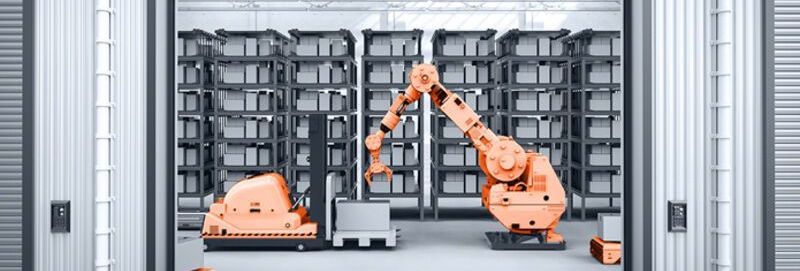
06.
Überwachung und Optimierung:
Überwachen Sie kontinuierlich die Leistung Ihres Logistikautomatisierungssystems, um Verbesserungsbereiche zu identifizieren. Sammeln und analysieren Sie Daten zu wichtigen E-Commerce-Kennzahlen wie Auftragsbearbeitungszeit, Bestandsgenauigkeit und Versandeffizienz. Nutzen Sie diese Daten, um Ihre Automatisierungsabläufe zu optimieren, notwendige Anpassungen vorzunehmen und kontinuierliche Verbesserungen voranzutreiben.
07.
Schulung und Unterstützung der Mitarbeiter:
Bieten Sie Ihren Mitarbeitern umfassende Schulungen und Unterstützung an, um sicherzustellen, dass sie effektiv mit dem neuen Automatisierungssystem arbeiten können. Schulen Sie sie im Umgang mit der Automatisierungssoftware, der Bedienung der Hardwarekomponenten und im Verständnis der neuen Prozesse. Bieten Sie fortlaufende Unterstützung an, um alle Fragen, Herausforderungen oder Bedenken während der Umstellung zu beantworten.
Die Zukunft der Logistikautomatisierung neu gestalten
Automatisierung schafft eine neue Zukunft der Nachhaltigkeit und Belastbarkeit für die Logistikbranche, indem sie Probleme wie Arbeitskräftemangel löst und Logistikunternehmen hilft, sich in der unsicheren Landschaft besser zurechtzufinden. Die wachsende Nachfrage nach personalisierten Logistikautomatisierungslösungen deutet darauf hin, dass die Zahl der Anwender von Logistikautomatisierung weiter steigen wird, wodurch die dringendsten Probleme im gesamten Sektor nach und nach beseitigt werden.
Seit mehr als 10 Jahren entwickeln wir Lösungen, die die Logistikautomatisierung vorantreiben. Wir sind stolz darauf, Beispiele dafür zu teilen, wie wir unseren Kunden geholfen haben, die Leistung zu maximieren, Innovationen voranzutreiben und das Wachstum voranzutreiben. Wir hoffen, dass die Erfolgsgeschichten unserer Kunden auch Ihre Geschäftstransformation inspirieren. Holen Sie sich jetzt ein kostenloses Audit.
„Bei 3S setzen wir auf Innovation und nutzen verschiedene Spitzentechnologien wie Augmented Reality (AR) und künstliche Intelligenz (KI), um die Betriebsabläufe unserer Kunden voranzutreiben. Mithilfe unserer AR-basierten Lösungen können unsere Kunden beispielsweise Echtzeitinformationen zum Motorzustand erhalten oder ihre Lager scannen und die beste Konfiguration bestimmen, was ihnen bei der Verwaltung von Lagerraum und -ressourcen hilft. Dank KI-basierter Lösungen reduzieren sie die Zeitverschwendung bei sich wiederholenden Aufgaben und können diese für wichtige Geschäftsanforderungen nutzen.“
10
Jahrelange Erfahrung
90
Erfolgreiche Projekte
15
Ausgebildete Fachkräfte
Holen Sie sich jetzt ein kostenloses Audit und erfahren Sie, wie wir Ihnen mit unserer umfassenden Expertise in E-Commerce-Logistik und -Automatisierung helfen können, Ihre Logistikprozesse zu optimieren, die Effizienz zu verbessern und das Unternehmenswachstum voranzutreiben.
UNSERE MISSION
Neue Möglichkeiten für Einzelpersonen und Organisationen zu schaffen, um die heutigen Herausforderungen zu bewältigen und die Zukunft der Logistikautomatisierung zu gestalten. Wir sind ständig auf der Suche nach neuen Möglichkeiten, um zu innovieren und konventionelle Grenzen zu überschreiten.
UNSERE VISION
Wir wollen der führende Technologiepartner für führende Marken und Top-Talente auf der ganzen Welt sein und mit der Geschwindigkeit der digitalen Transformation außergewöhnliche Werte schaffen
WIE WIR ARBEITEN
Wir kombinieren unser Talent mit modernsten Technologien, um Lösungen zu schaffen, die neue Produktivitätsstandards erfüllen und die Erwartungen des Marktes übertreffen.
Bleiben Sie in einer sich rasch entwickelnden digitalen Landschaft wettbewerbsfähig.
Wir sind davon überzeugt, dass Zusammenarbeit ein Schlüsselfaktor für den Erfolg in der Logistik ist. Durch den Aufbau starker Partnerschaften mit Lieferanten, Spediteuren und anderen Beteiligten optimieren wir Abläufe, teilen Ressourcen und nutzen zusätzliches Fachwissen. Gemeinsam mit unseren Partnern ermöglichen wir Unternehmen, Abläufe zu optimieren, Kosten zu senken, die Effizienz zu steigern und das Kundenerlebnis zu verbessern. Durch den Einsatz von 3S-Lösungen können Unternehmen in einer sich schnell entwickelnden digitalen Landschaft wettbewerbsfähig bleiben.
Da die Kundennachfrage steigt, müssen Unternehmen eine schnellere und genauere Auftragsabwicklung anbieten. Ein schwaches und unorganisiertes Wareneingangs- und Einlagerungssystem kann jedoch die Erfüllung von Zusagen verzögern. Eine effiziente Lagerverwaltung ist für eine stabile Lieferkette Ihres E-Commerce-Unternehmens von entscheidender Bedeutung. Ungenauigkeiten beim Wareneingang oder bei der Einlagerung können Unternehmen Zeit kosten, den Gewinn schmälern und zum Verlust von Kunden führen.
Die Planung, Implementierung und der Betrieb einer Logistikautomatisierung können komplex sein. Mit unserer Expertise in E-Commerce-Logistik und -Automatisierung kann 3S Sie durch den Prozess führen, maßgeschneiderte Lösungen bereitstellen und eine erfolgreiche Implementierung sicherstellen.
Wenn Sie derzeit auf der Suche nach einem solchen Technologiepartner für Ihr Logistikautomatisierungsprojekt sind, fordern Sie noch heute ein kostenloses Audit an. Unsere Berater und Entwickler haben bereits zahlreiche einzigartige Logistikautomatisierungssysteme erfolgreich fertiggestellt und eingeführt und unterstützen Sie bei der Erstellung einer einzigartigen, wettbewerbsfähigen Lösung, die auf Ihre spezifischen Anforderungen zugeschnitten ist.
Melden Sie sich für ein „kostenloses Audit“ an und wir melden uns innerhalb von 24 Stunden bei Ihnen, um zu besprechen, welche Dienste für Ihre Geschäftsanforderungen am besten geeignet sind. Oder sprechen Sie jetzt mit uns und teilen Sie uns mit, was Sie benötigen.
„Bei 3S entwickeln wir eine Kultur, die Kreativität fördert und unseren Talenten die Möglichkeit gibt, ihr volles Potenzial zu entfalten. Indem wir in unsere Mitarbeiter investieren, sind wir in der Lage, Innovationen voranzutreiben, die die Erwartungen unserer Kunden übertreffen und ihnen helfen, unkonventionelle Wege zu finden, um ihre ehrgeizigsten Ziele zu erreichen.“
3S Blog
